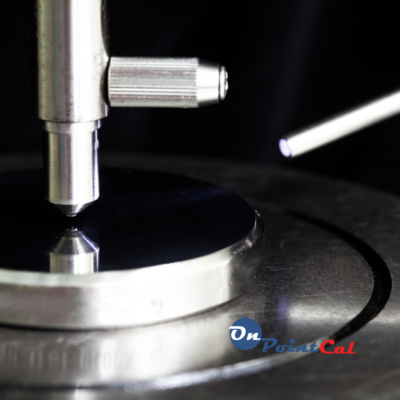Manufacturing, Quality Assurance, Technological Innovations
Rockwell vs. Superficial Rockwell Hardness Testing: An Engineer’s Insightful Journey
In the meticulous world of engineering, every detail matters. While the conventional Rockwell hardness testing method reigns supreme for its precision, its counterpart, the Superficial Rockwell, garners attention for specialized niches. As your ISO 17025 accredited calibration partner, OnPointCal delves into the intricacies of these testing methods, aiming for clear insights.

Deep Dive into Rockwell Hardness Testing
The Rockwell method is the gold standard for measuring a material’s resistance to indentation. The process involves an initial minor load, followed by a more substantial major load. The subsequent depth of penetration under this major load determines the Rockwell number, representing the material’s hardness.
The Subtleties of Superficial Rockwell Hardness
Designed exclusively for thinner materials or specific surface layers, the Superficial Rockwell method operates with lighter loads. This reduced pressure results in a less profound depth, making it ideal for applications like coatings, thin-wall tubing, and plated surfaces.
Applications in the Real World
Rockwell Hardness Testing
- Automotive Strength: Engine blocks, transmission systems, and performance gears.
- Versatility in Metals: Applicable across a wide spectrum of metals and alloys.
- The Quality Control Standard: A go-to for manufacturers prioritizing quality.
Superficial Rockwell Testing
- Aerospace Excellence: Perfect for evaluating aerospace coatings and lightweight materials.
- Electronic Frontiers: Key for resilience testing in semiconductor materials and delicate metallic films.
- Medical Precision: For assessing the robustness of tiny medical devices like stents.
Analysis: Strengths and Challenges
Traditional Rockwell Testing
Pros
- Quick, timely results.
- Versatile material compatibility.
- Minimal preparation needs.
Cons
- Not ideal for very thin materials.
- Dependence on operator skill.
Superficial Rockwell Testing
Pros
- Exceptional precision for thin materials.
- Reduced material deformation risks.
Cons
- Not for deeper penetration testing requirements.
- Requires investment in specialized equipment.
Concluding Thoughts
Both Rockwell and Superficial Rockwell showcase their unique merits. The selection often rests on specific project needs. For expert calibration and tailored insights, OnPointCal remains your premier ISO 17025 calibration authority. Explore further at www.onpointcal.com.


